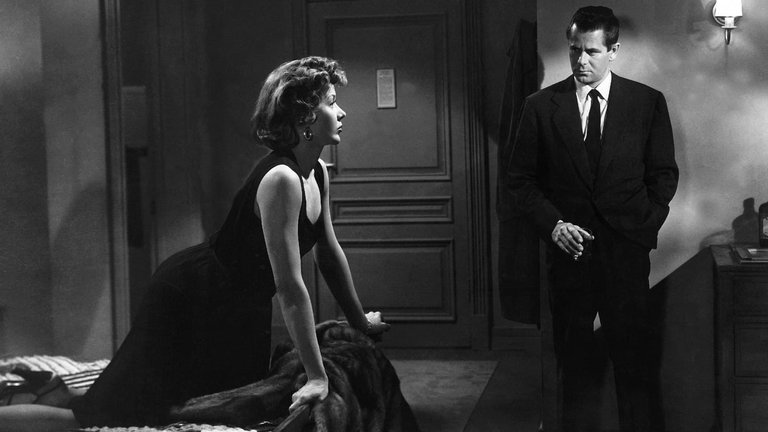Film Review: The Big Heat (1953)

The film noir genre is inherently dark, but The Big Heat, 1953 film directed by Fritz Lang, takes this darkness to another level, resulting in one of the classics of the genre.
The film is based on the eponymous novel by William P. McGivern's, inspired by his first-hand experiences as crime reporter in Philadelphia (renamed into fictional “Kenport” in the film). The plot begins with the suicide of a corrupt police official, which is being investigated by the protagonist, Sergeant Dave Bannion (played by Glenn Ford). The man’s widow Bertha Duncan (played by Jeanette Nolan) suggests that her husband has taken his life because of poor health, but Bannion soon learns different story from his girlfriend Lucy Chapman (played by Dorothy Green) who is soon afterwards brutally murdered. Bannion concludes that it has something to do with Mike Lagana (played by Alexander Sourby), rich and powerful mob boss that has entire city, including many policemen, in his pocket. Bannion continues to investigate despite his superiors telling him not to and, following the phone threat, his wife Katie (played by Jocelyn Brando) gets killed by a car bomb intended for him. Bannion is even more determined to bring gangsters to justice and, despite being suspended from the force because of insubordination, receives help from Debby Marsh (played by Gloria Grahame), sultry girlfriend of Vince Stone (played by Lee Marvin), Lagana’s violent and sadistic lieutenant and enforcer.
The Big Heat is an atypical film noir. Unlike traditional works of the genre where the femme fatale drives men to death and destruction, this film subverts these tropes. Instead, it is an honest policeman and perfect family man who serves as the catalyst for chaos and tragedy, and whose actions, directly or indirectly, lead to deaths of four women, including his wife. Fritz Lang, known for his pioneering work in development of modern genre of thriller, provides masterful direction. He maintains a quick pace and concise storytelling, allowing The Big Heat to be wrapped within hour and half of running time.
Lang, also known for delving into very dark subjects, like those in his 1931 masterpiece M, again explores some dark territory and his film looked quite daring for standards of 1950s Hollywood in portraying violence against women. Those included shocking scene of the car bombing and even more shocking scene in which Gloria Grahame’s character gets disfigured by hot coffee. Those scenes pushed the boundaries of mainstream Hollywood at the time and paved the way for gradual easing of the strict censorship rules of Hays Code, that would take place later in 1950s.
The script paints very dark picture of the pervasive issue of powerful and ruthless gangsters in big American cities, where organized crime intertwines with corrupt officials. The main villain, played by Alexander Sourby, is, on the other hand, intelligent and quite aware that gangland empires can be brought down with sufficient levels of public scrutiny and political will. Infamous mob boss Lucky Luciano, who had been deported from USA few years earlier and probably served as one of models for Lagana, is even mentioned by name by the character. Lang, on the other hand, tempers this darkness by adding flickers of hope in humanity through the characters like crippled secretary (played by Edith Evanston) who provides crucial information to Bannion out of mere kindness or Bannion’s WW2 veteran friends who volunteer as security for his family when corrupt police refuses to do so.
The acting in The Big Heat is generally solid, although Glenn Ford as mostly one-dimensional crusader is overshadowed by actors playing characters that are either evil (like Lee Marvin in his early roles) or morally ambiguous. Gloria Grahame's portrayal of the gangster's moll stands out as a multi-faceted and tragic character, adding both film noir iconography and realism. The film's conclusion veers slightly into melodrama, contrasting with its otherwise gritty and realistic tone. Despite some flaws, The Big Heat emerges as a standout film noir classic, deserving its reputation for its bold storytelling, dark themes, and impactful portrayal of a corrupt society.
RATING: 8/10 (+++)
Blog in Croatian https://draxblog.com
Blog in English https://draxreview.wordpress.com/
InLeo blog https://inleo.io/@drax.leo
Hiveonboard: https://hiveonboard.com?ref=drax
Rising Star game: https://www.risingstargame.com?referrer=drax
1Inch: https://1inch.exchange/#/r/0x83823d8CCB74F828148258BB4457642124b1328e
BTC donations: 1EWxiMiP6iiG9rger3NuUSd6HByaxQWafG
ETH donations: 0xB305F144323b99e6f8b1d66f5D7DE78B498C32A7
Posted using CineTV

I am fascinated by police plots, this analysis presents it in a very interesting way, it encourages me to watch it. Greetings my friend @drax